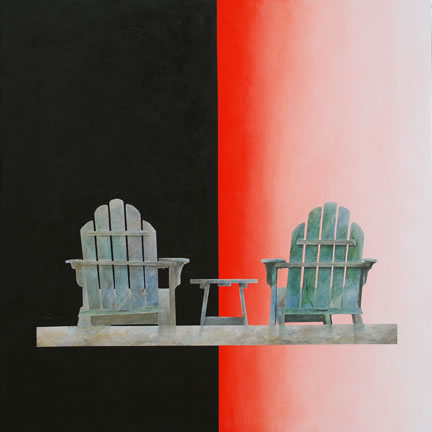
Joseph Kinnebrew’s paintings invite us – just about taunt us – into an interpretive mindset. But pulling apart Kinnebrew’s elaborate concatenations of things and spaces proves strangely unsatisfying: we wind up not with answers, but with all the parts, the flowers, the clouds, the monkeys, the nudes, the checkerboards, the bodies of water, just lying around unconcatenated. We find ourselves relying on conventional translations, would-be psychologists trying to unravel dreams that either resist our tinkering or come apart in our hands. To seek meaning in these pictures is to meddle in them.
Kinnebrew’s canvases, if anything, urge us to admire dreams simply as dreams, and by inference, life as life. Various components of these images may signify various things to various viewers – and various things to Kinnebrew – but what drives Kinnebrew’s work is not what they mean, but how they fall together, how the components conflate incongruously and establish a new reality out of that very incongruity. Sense results from sensation, not from any syntax of symbols.
Dreams themselves work like that. They may point at clues to the dreamer’s inner (or outer) life, but they do not betray that life. Indeed, they may obscure it with poetic occlusion. Like our DNA, the bulk of which is random, functionless, and thus “meaningless,” our dreams by and large result from our minds simply shooting off sparks in response to our waking stimuli, our memories, our impressions. You could say that Kinnebrew’s art is a kind of impressionism, but an impressionism of the mind, not the eye.
Of course, the modernist mode most applicable to Kinnebrew’s pictorial art is surrealism. His visual language is classically surrealist, and his embrace of the visual non sequitur recapitulates the approach of a host of painters, from Salvador Dalí and René Magritte to Pierre Roy and Félix Labisse. What is new here under the sun – or moon – is not the method, but the madness. These are Kinnebrew’s obsessions, not Dalí’s or Labisse’s.
Kinnebrew’s dreamscapes can be described as people and things in places, that is, arrangements of figures in deeply recessional grounds. The spaces are dramatic, often more so than the objects and creatures that occupy them. Nowadays one regards such amalgamations with suspicion, assuming them to have been knocked together in Photoshop or some other digital means of reassembling visual information. If Kinnebrew relies on the computer to compose his visions, he doesn’t show the seams when he paints them. Although things can seem to be allotted positions arbitrarily, the way in which they occupy those positions seems comfortable – decorous, ornate, almost exaggeratedly classical, but settled and self-possessed, almost logical in the face of it.
Kinnebrew’s pictorial language is as fractured as the era that has birthed them. They defy coherency, just as the modern – and, yes, the post-modern – era does. But since they mirror our world and reflect back at us our sense of the border between inner and outer reality, they make their own sense to us. We don’t need to interpret Joseph Kinnebrew’s paintings; we already understand them.
Peter Frank Los Angeles March 2010
Peter Frank writing about Joseph Kinnebrew (2010)
Peter Frank is art critic for the Huffington Post and Senior Curator at the Riverside [CA] Art Museum. He has previously served as art critic for the LA Weekly, Angeleno magazine, the Village Voice, and the SoHo Weekly News; has edited THEmagazine Los Angeles and Visions art quarterly; and has curated exhibitions at the Guggenheim Museum, Madrid's Museo Reina Sofia, and other venues around the world.

